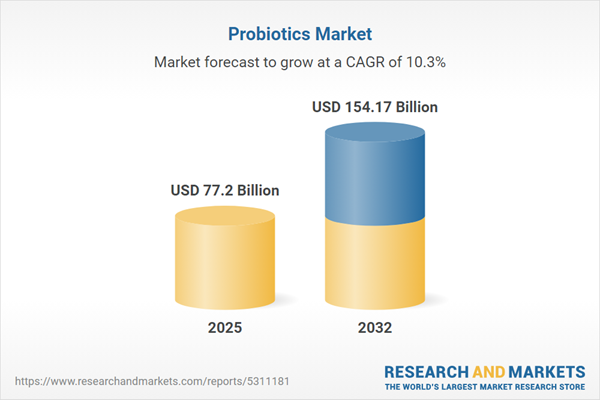Speak directly to the analyst to clarify any post sales queries you may have.
The probiotics market is undergoing significant transformation as industry innovation, scientific advancements, and evolving consumer health priorities drive broad adoption and segmentation across multiple verticals.
Market Snapshot: Probiotics Market
The probiotics market grew from USD 70.34 billion in 2024 to USD 77.20 billion in 2025. It is projected to continue at a robust CAGR of 10.30%, reaching USD 154.17 billion by 2032. Widespread awareness of the connection between gut microbiota and personal wellness, combined with product innovation, is fueling sector resilience and long-term expansion. Key drivers include rising demand for tailored health solutions, intensive research unlocking novel strain-specific benefits, and diversification into new delivery formats across multiple industries.
Scope & Segmentation
- Product Types: Dietary supplements (capsules, powders, tablets), feed, food and beverage (dairy, non-dairy), personal care products (haircare, skincare).
- Sources: Bacteria-based probiotics and yeast-derived strains offering stability and distinctive health properties.
- Applications: Digestive health, immune health, oral health, urogenital health solutions for human and animal end-users.
- Distribution Channels: Offline outlets (pharmacies, specialty stores) and online channels, including subscription models and direct-to-consumer strategies.
- Key Regions: Americas (North America, Latin America), Europe Middle East & Africa (United Kingdom, Germany, France, Middle East, Africa), Asia-Pacific (China, India, Japan, Australia, and more).
- Leading Technologies: Microencapsulation, next-generation sequencing, and digital health platforms used to enhance probiotic development, stability, and personalization.
- Featured Companies: Alltech, Inc., Archer Daniels Midland Company, Arla Foods, Asahi Group Holdings, BioGaia AB, Chr. Hansen Holding, DuPont de Nemours, Evonik Industries, Kerry Group, Lallemand, and others.
Key Takeaways for Decision-Makers
- Scientific research and regulatory accountability are enabling precise, evidence-backed claims for probiotic efficacy, boosting consumer trust and market transparency.
- Delivery innovation is expanding the spectrum of product formats, supporting both conventional supplements and new opportunities in functional foods, beverages, and personal care.
- Collaborative R&D and strategic partnerships accelerate market entry while enabling compliance with diverse regional regulations.
- Sustainability initiatives in production and raw material sourcing enhance supply chain resilience and support environmental stewardship across the industry.
- The shift toward digital engagement and subscription-based models supports higher customer retention and offers accessible, tailored probiotic regimens to new demographics.
- Personalized formulations for both human and animal health drive engagement and strengthen customer loyalty, expanding the value proposition for multiple application areas.
Tariff Impact: Navigating U.S. Policy Changes
The 2025 introduction of enhanced U.S. tariffs has prompted probiotics stakeholders to reconfigure global supply chains, stimulate regional production hubs, and diversify sourcing. These shifts are driving cost management initiatives and reinforcing supply network agility, ultimately leading to a broader, more resilient market ecosystem prepared for potential future policy shifts.
Methodology & Data Sources
This analysis utilizes a mixed-method research approach that incorporates direct interviews with senior industry executives, scientists, supply chain experts, and commercialization strategists. These insights are cross-referenced with secondary intelligence from regulatory filings, peer-reviewed journals, and proprietary databases. Data triangulation and cross-regional mapping techniques have been employed to ensure balanced and actionable findings.
Why This Report Matters
- Provides actionable insights for strategic planning, including technology priorities, supply chain optimization, and market expansion pathways tailored to senior leadership needs.
- Enables competitive benchmarking of key players and identifies opportunities for differentiation through innovation, sustainability, and digital engagement.
- Offers a detailed framework for assessing regional trends and understanding shifting policy and regulatory impacts on business operations.
Conclusion
With evolving health priorities, scientific rigor, and regulatory frameworks shaping the probiotics landscape, stakeholders poised to act on these insights will be well equipped to sustain growth, innovation, and resilience within this expanding ecosystem.
Additional Product Information:
- Purchase of this report includes 1 year online access with quarterly updates.
- This report can be updated on request. Please contact our Customer Experience team using the Ask a Question widget on our website.
Table of Contents
3. Executive Summary
4. Market Overview
7. Cumulative Impact of Artificial Intelligence 2025
Companies Mentioned
The companies profiled in this Probiotics market report include:- Alltech, Inc.
- Archer Daniels Midland Company
- Arla Foods, Inc.
- Asahi Group Holdings, Ltd.
- Bio Armor Developpement S.A.R.L. by The Kersia Group
- BioCC LLC
- BioGaia AB
- Chr. Hansen Holding A/S
- DuPont de Nemours, Inc.
- Evonik Industries AG
- Greentech
- Kerry Group PLC
- Lallemand Inc.
- Land O'lakes, Inc.
- Lesaffre & CIE
- Lifeway Foods, Inc.
- MITUSHI BIOPHARMA
- Morinaga Milk Industry Co., Ltd.
- Mother Dairy Fruit & Vegetable Pvt. Ltd.
- Nestlé S.A.
- Novozymes A/S
- Probi AB
- Probiotical SpA
- Provita Eurotech Limited
- Reckitt Benckiser Group plc
- Roelmi HPC
- Royal DSM N.V.
- Sabinsa Corporation
- Schouw & Co.
- Synbio Tech Inc.
- Yakult Honsha Co., Ltd.
Table Information
| Report Attribute | Details |
|---|---|
| No. of Pages | 181 |
| Published | November 2025 |
| Forecast Period | 2025 - 2032 |
| Estimated Market Value ( USD | $ 77.2 Billion |
| Forecasted Market Value ( USD | $ 154.17 Billion |
| Compound Annual Growth Rate | 10.3% |
| Regions Covered | Global |
| No. of Companies Mentioned | 32 |









